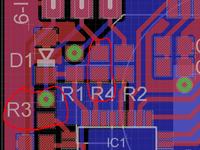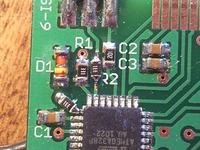When it comes to manually setting FuseBits, I think it would be best to enter them character by character in the hex, i.e. first select the first character (two buttons up and down) and then the next one and we have the whole fuse.

Czy wolisz polską wersję strony elektroda?
Nie, dziękuję Przekieruj mnie tamnarasta wrote:When it comes to manually setting FuseBits, I think it would be best to enter them character by character in the hex, i.e. first select the first character (two buttons up and down) and then the next one and we have the whole fuse.
george2002 wrote:Yes, AVR-DOS. The new one is KokkeKat. Free even for commercial use. But I didn't feel like changing it anymore, and the project is 100% free anyway. SDHC is also for AVR-DOS, that's what I meant. The issue of replacing the file and testing, perhaps it will be in the next update - although I do not know why an 8GB card for storing 32kB files is for ;)What library does my colleague use in Bascom to support SD? I assume that from the new one that has recently been written by a man for free? or with AVR-DOS?
Oops I read on the website and I conclude that it is AVR-DOS but the plans are for a better version
george2002 wrote:It would be nice if you could change the coffee grounds through this programmer
george2002 wrote:You can add programming time under the progress bar - a very cool and useful thing and I doubt if it messes with the program / speed, it would be even better to write the time to finish programming
george2002 wrote:No, I already mentioned that. However, if someone is interested in the details of the implementation of individual functions, I can show what is done and how.Is it possible to get an uncompiled version as a BAS file?
piotrusgit wrote:1) If I read it correctly, is it possible to upload only one version of the program to the programmer?
2) Is your colleague going to make the option of selecting a file for programming? For example, I upload 10 programs to uProg and choose the current version on the spot
3) Is it possible to download the program from the microcontroller connected to the programmer (backup)
farrix wrote:I have one more question for my friend, could my friend share (or send me via e-mail) a piece of bootloder responsible for programming the atmega flash memory, I mean exactly to which registers the colleague sends, what packages (the point is that you have to send to flash by pages) , and what also needs to be scratched in assembly language.
Klima wrote:Could you describe the method of mounting the display in more detail?
manekinen wrote:Klima wrote:Could you describe the method of mounting the display in more detail?
Exactly what? How did I make these handles? Because this display is only held on the handles. There is no need to describe it too much, it is a fragment of such a plugin:
http://sklep.avt.pl/photo/product_info/4/b/e/1_4be6aaab5d20.jpg
I do not remember whether male or female, but one of them has these partitions, exactly 5.2 mm wide, and this is the perfect width to catch the display with the plate. It is enough to saw off what is needed and sand it nicely. After that, the display lies on the SD card slot and a contact eraser. The left side is hanging in the air, but you can stick something on because there is too much pressure and you can say goodbye to the display
farrix wrote:Therefore, if a colleague has some knowledge on this subject, or knows the pages about it, I would be grateful.
J_Bravo wrote:I suggest to add the fusebits / lockbits programming option automatically after Flash programming.
krzysiekdg wrote:I also join the proposal if it is possible, It will make things easier for many inexperienced beginners.
Automatic setting of fusebits of the programmed circuit by the programmer.
manekinen wrote:J_Bravo wrote:I suggest to add the fusebits / lockbits programming option automatically after Flash programming.
krzysiekdg wrote:I also join the proposal if it is possible, It will make things easier for many inexperienced beginners.
Automatic setting of fusebits of the programmed circuit by the programmer.
But where is this automation going to come from? I mean, how should the programmer know what settings to save? I've never used options like this so I don't know. Compilers automatically generate additional fuska files?
manekinen wrote:What program does it generate? WinAvr? The fusebit file is probably just a regular BIN, but with the FUS extension? I would like to upload a sample file like this, I would like to preview it :)
An interesting proposal, when uploading a flash file, the programmer would check if there are files with the same name in other folders and automatically upload them
$PROG &HFF, &HE2, &HDF, &HF8 FF
E2
DF
F8
Quote:1.If I upload a hex to this atmega 328p, will the system work immediately?
Quote:
From what I saw, it is impossible to set fusebits in it.
Quote:2. Will the system work without a memory card with the necessary files on this card?
krzysiekdg wrote:1.If I upload a hex to this atmega 328p, will the system work immediately?
From what I saw, it is impossible to set fusebits in it.
2. Will the system work without a memory card with the necessary files on this card?
mlassota wrote:The only problem you can have is the extended bits - there can be two values of 07 or FF
mlassota wrote:Unfortunately ... I released two processors - through my own fault ... This processor should be programmed from 3.3V or 5V (unpinning the display and card) the entire uProg should be powered.
As I agreed with the author, to whom I would like to congratulate you once again and thank you for your help, the remaining lines, ie SCK and MISO, should have 220R resistors and a 3.3V Zener diode ... It will be safer.
leonow32 wrote:Access problem ??? Or rather with soldering? In every store they have SMD, and in some (also on Allegro) they sell whole sets, e.g. a set of E12 series resistors from 1R to 1M. I once bought such a set of resistors and capacitors, and I never complain about "availability". And as for the assembly - it is EASIER than through-hole! At least because you do not need to drill holes and turn the plates to solder the element.


